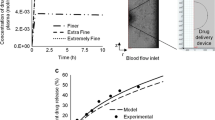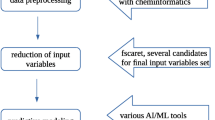Abstract
Purpose. The aim of this project was to develop a colloidal dosage form for the oral delivery of rifampicin and isoniazid in combination with the aid of artificial neural network (ANN) data modeling.
Methods. Data from the 20 pseudoternary phase triangles containing miglyol 812 as the oil component and a mixture of surfactants or a surfactant/cosurfactant blend were used to train, test, and validate the ANN model. The weight ratios of individual components were correlated with the observed phase behavior using radial basis function (RBF) network architecture. The criterion for judging the best model was the percentage success of the model prediction.
Results. The best model successfully predicted the microemulsion region as well as the coarse emulsion region but failed to predict the multiphase liquid crystalline phase for cosurfactant-free systems indicating the difference in microemulsion behavior on dilution with water.
Conclusions. A novel microemulsion formulation capable of delivering rifampicin and isoniazid in combination was created to allow for their differences in solubility and potential for chemical reaction. The developed model allowed better understanding of the process of microemulsion formation and stability within pseudoternary colloidal systems.
Similar content being viewed by others
References
World Health Organisation TB Report 1998, World Health Organisation Press Office, Geneva, 1998.
South African Medicines Formulary (4th ed.). Department of Pharmacology, UCT, Pioneer Press, 1997, pp. 260-270.
MIMS. Medical Specialities, Times Media. Pretoria 39:289-293 (1999).
M. J. Lawrence. Microemulsions as drug delivery vehicles. Curr. Opin. Colloid Interface Sci. 1:826-832 (1996).
M. Malmsten. Microemulsions in pharmaceuticals. In P. Kumar, K. L. Mittal (eds.), Handbook of Microemulsion Science and Technology, Marcel Dekker, New York, 1999.
D. Attwood and G. Ktistis. A light scattering study on oil in water microemulsions. Int. J. Pharm. 52:165-171 (1989).
P. P. Constantinides and P. J. Scalart. Formulation and physical characterization of water in oil microemulsions containing long-versus medium-chain glycerides. Int. J. Pharm. 158:57-68 (1997).
J. Moody and C. J. Darkin. Fast learning in networks of locally-tuned processing units. Neural Comput. 1:281-294 (1989).
S. Haykin. Neural Networks: A Comprehensive Foundation. Macmillan, New York, 1994.
C. Bishop. Neural Networks for Pattern Recognition. Oxford University Press, Oxford, 1995.
M. Egmont-Petersen, J. L. Talmon, and A. Hasman. Assessing the importance of features for multi-layer perceptrons. Neural Networks 11:623-635 (1998).
G. Bologna, and C. Pellegrini. Three medical examples in neural network rule extraction. Phys. Med. 13:183-187 (1997).
T. F. Rathbun, S. K. Rogers, and M. P. DeSimio. MLP iterative construction algorithm. Neurocomputing 17:195-216 (1997).
J. Kreuter. Colloidal Drug Delivery Systems, Marcel Dekker, New York, 1994.
R. Aboofazelia, N. Patela, M. Thomasb, and M. J. Lawrencea. Investigations into the ormation and characterization of phospholipid microemulsions. IV. Pseudo-ternary phase diagrams of systems containing water-lecithin-alcohol and oil; the influence of oil. Int. J. Pharm. 125:107-116 (1995).
M. Trotta, M. Gallarate, F. Pattarino, and M. E. Carlotti. Investigation of the phase behaviour of systems containing lecithin and 2-acyl lysolecithin derivatives. Int. J. Pharm. 190:83-89 (1999).
D. Attwood. Microemulsions. In H. Kreuter (ed.), Colloidal Drug Delivery Systems, Marcel Decker, New York, 1994, p. 31.
R. G. Alany, T. Rades, S. Agatonovic-Kustrin, N. G. Davies, and I. G. Tucker. Effect of alcohols and diols on the phase behaviour of quaternary systems. Int. J. Pharm. 196:141-145 (2000).
R. G. Alany, N. G. Davies, I. G. Tucker, and T. Rades. Characterising colloidal structures of pseudoternary phase diagrams formed by oil/water/amphiphile systems. Drug Dev. Ind. Pharmacy 27:31-38 (2001).
Author information
Authors and Affiliations
Corresponding author
Rights and permissions
About this article
Cite this article
Agatonovic-Kustrin, S., Glass, B.D., Wisch, M.H. et al. Prediction of a Stable Microemulsion Formulation for the Oral Delivery of a Combination of Antitubercular Drugs Using ANN Methodology. Pharm Res 20, 1760–1765 (2003). https://doi.org/10.1023/B:PHAM.0000003372.56993.39
Issue Date:
DOI: https://doi.org/10.1023/B:PHAM.0000003372.56993.39




